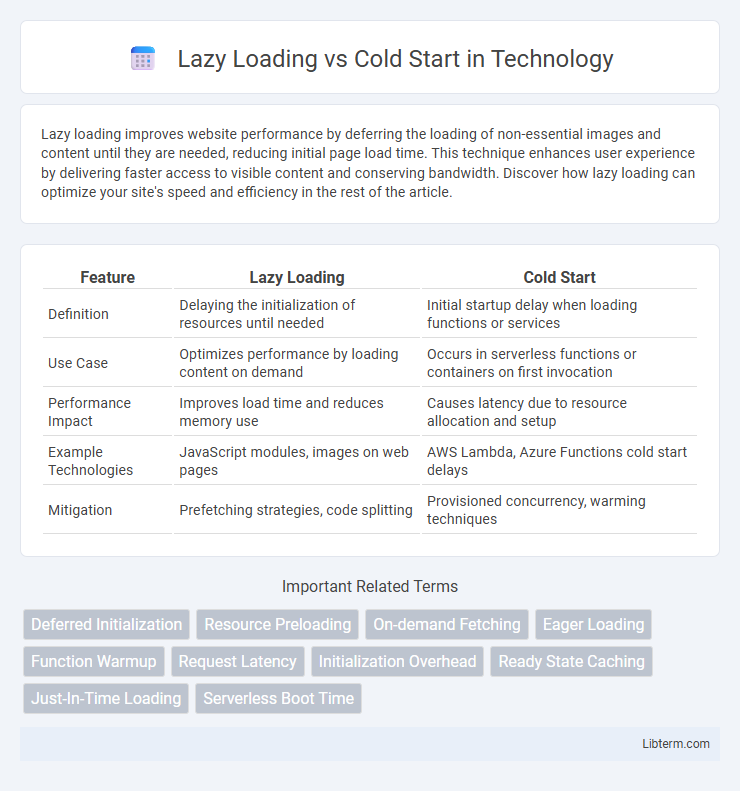Lazy loading improves website performance by deferring the loading of non-essential images and content until they are needed, reducing initial page load time. This technique enhances user experience by delivering faster access to visible content and conserving bandwidth. Discover how lazy loading can optimize your site's speed and efficiency in the rest of the article.
Table of Comparison
| Feature | Lazy Loading | Cold Start |
|---|---|---|
| Definition | Delaying the initialization of resources until needed | Initial startup delay when loading functions or services |
| Use Case | Optimizes performance by loading content on demand | Occurs in serverless functions or containers on first invocation |
| Performance Impact | Improves load time and reduces memory use | Causes latency due to resource allocation and setup |
| Example Technologies | JavaScript modules, images on web pages | AWS Lambda, Azure Functions cold start delays |
| Mitigation | Prefetching strategies, code splitting | Provisioned concurrency, warming techniques |
Understanding Lazy Loading
Lazy loading improves application performance by deferring the initialization of resources until they are actually needed, reducing initial load times and memory usage. This technique contrasts with cold start scenarios where all components start simultaneously, often causing slower application response times and increased latency. Implementing lazy loading in cloud functions or web apps effectively minimizes overhead by activating features on-demand, enhancing user experience and resource efficiency.
What is Cold Start?
Cold Start refers to the initial delay experienced when a serverless function or application is invoked for the first time, requiring the platform to provision resources and initialize the environment. This latency occurs because the underlying infrastructure must load the application code, dependencies, and runtime before executing the function. Minimizing cold start time is critical for improving performance in cloud computing and serverless architectures.
Key Differences Between Lazy Loading and Cold Start
Lazy loading defers the initialization of resources until they are actually needed, improving application performance and reducing initial load times. Cold start refers to the delay experienced when a serverless function or application initializes for the first time or after a period of inactivity, causing latency. Unlike lazy loading, which optimizes resource usage during runtime, cold start is a startup latency issue inherent in serverless and containerized environments.
Performance Impacts: Lazy Loading vs Cold Start
Lazy loading improves performance by deferring the initialization of resources until they are needed, reducing initial load times and memory usage. Cold start causes significant latency as the system initializes from scratch, impacting response times and user experience negatively. Optimizing lazy loading techniques can mitigate cold start delays, particularly in serverless computing and mobile applications where startup speed is critical.
Use Cases for Lazy Loading
Lazy loading enhances website performance by deferring the loading of non-critical resources, such as images and videos, until they are needed, making it ideal for content-heavy pages and long-scrolling sites. It reduces initial page load time and bandwidth usage, improving user experience on mobile devices and slower networks. This technique is commonly used in e-commerce platforms, social media feeds, and content management systems to efficiently manage resource consumption and maintain fast interactions.
Scenarios Where Cold Start Matters
Cold start significantly impacts serverless applications in high-traffic scenarios where immediate response time is critical, such as real-time data processing or online gaming. It can cause latency spikes when functions are invoked after periods of inactivity or updates, affecting user experience and system performance. Optimizing cold start involves strategic function deployment, warm-up techniques, and minimizing package size to reduce initialization delays in cloud environments like AWS Lambda or Azure Functions.
Advantages of Lazy Loading
Lazy loading improves application performance by deferring the initialization of resources until they are needed, reducing startup time and memory consumption. It enhances user experience through faster initial load times and lower latency during interaction. This method optimizes resource utilization and scalability by loading components on demand instead of preloading everything at launch.
Drawbacks of Cold Start
Cold start in serverless computing causes significant latency as functions require initialization before execution, resulting in slow response times during the first request. This delay negatively impacts user experience and makes cold start unsuitable for latency-sensitive applications. High frequency of cold starts increases resource consumption and operational costs, reducing the overall efficiency of cloud functions.
Best Practices for Implementation
Lazy loading reduces memory usage and enhances application responsiveness by deferring resource initialization until necessary, making it ideal for optimizing performance in large-scale web apps. Mitigate cold start latency in serverless environments by employing techniques such as function warm-up, keeping dependencies minimal, and using native language runtimes to speed up initialization time. Implement telemetry and monitoring tools to track cold start occurrences and lazy load triggers, enabling continuous performance tuning and resource allocation adjustments.
Choosing Between Lazy Loading and Cold Start
Choosing between lazy loading and cold start depends on application performance priorities and user experience goals. Lazy loading optimizes resource use by loading components only when needed, reducing initial load time and improving responsiveness in dynamic content environments. Cold start impacts are more pronounced in serverless or cloud functions, where minimizing startup latency is crucial for fast execution and cost efficiency.
Lazy Loading Infographic

 libterm.com
libterm.com